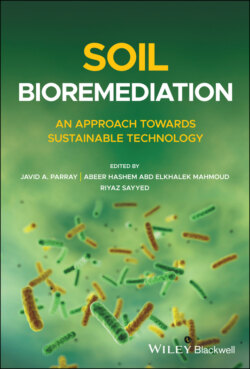Читать книгу Soil Bioremediation - Группа авторов - Страница 40
2.7 Behavior of Inorganic and Organic Pollutants in Soil
ОглавлениеTranslocation, mobility, uptake, and accumulation of contaminants in plants are noticeably caused by main two factors: (i) environmental factors, and (ii) genetic makeup between plant species to uptake contaminants, their translocation and storage to different organs and plant resistance against specific contaminants. These mechanisms of contaminants in different parts of plants are known to differ and are also imbalanced. The uptake mechanisms for organic or inorganic complexes are also diverse. The movement of inorganic compounds within plants for example, nutrients, metals, and metalloids is generally carried out by through active transport and passive diffusion. An example, using Ni, showed that passive diffusion was influenced at a high concentration of nickel whereas active transport of Ni2+ was revealed to play a vital role in its uptake from medium to low concentrations of Ni. Inorganic contaminants, usually transportation of metals, are carried from root membranes with the support of membrane transport proteins that belong to the CDF proteins family (cation diffusion facilitators). It is remarkable that a binding domain of protein identifies only specific ions and is responsible for its transportation [132]. In contrast to the inorganic translocation system, organic contaminants don't have any specific carrier to carry them through the plant. They simply move into the symplast and xylem apoplast due to their hydrophobicity and also pass into the leaves by simple diffusion [133]. Moreover, translocation of both organic and inorganic pollutants is influenced by soil rhizosphere microorganisms, which are in symbiosis with the roots [129, 134]. Microorganisms also have diverse functions, for example, they excrete organic compounds to the soil, which increases the bioavailability in the soil, and the transit of metals to the plant from the roots, they may also alter their chemical properties, which could make them harmless, harmful, mobile, or immobile [117].
Due to the distinct ability of HM accumulation in plants, they are divided into three classes: accumulators – obtain high levels of metals on the surface of the ground, easy to reap organs, and self‐reliance of metal concentrations in the soil; excluders – they have very confined transit of metals to the shoots from the roots even if the soil is enrich with the metal contaminants; indicators – they manifest the levels of metal contamination in the rhizospheric soil [135]. Furthermost the plants belong to the class of excluder, as in the case of Pb, its translocation to the shoots is very confined but it accumulates in the cell walls of the cortex due to the weak transportation of metal ions to the shoots [136], or due to the prolonged distance between the shots/roots [125]. The degree of metal uptake and its translocation varies from plant to plant spices and it is one of the most notable features of plant resistance [137]. Whereas the ability of HM accumulation to one or another level, they are recognized as hyperaccumulators, accumulators, and nonaccumulators [138]. Hyperaccumulators have 100 times higher concentrations in their shoots than nonaccumulators. Until now, about 400 species have been characterized as metal hyperaccumulators as they genetically have great capacity to accumulate high levels of HM in their shoots. At the time of uptake from the roots, the major fraction of metal is present in the plant rhizodermis and cortex [134, 139, 140]. The distribution of metals in hyperaccumulator plants is truly systemized through proficiency of many detoxification mechanisms and is determined by the features of metal transport. Ni is easily transported to the tissues of stele, while the distribution of Cd and Pb is limited to the central cylinder by the endodermis. The accumulation and distribution of organic compounds in plants includes three phases: enzymatic modification and degradation, conjugation, and sequestration in cell walls [124]. To date, it is anticipated that using some biotechnological approaches and genetic engineering utilizing the knowledge of the metabolic and genetic processes regulating a metal tolerance will add to the plant resistance and accumulation of HMs. Solubility of metal and other contaminants and their bioavailability to the plants is chiefly effected by the chemical properties of soil for example, cation exchange capacity, loading rate, soil pH, redox potential, organic matter, soil texture, and clay content [141, 142]. Normally, higher levels of organic matter or clay and soil pH enhance chelation effect and the metals will be strongly bound to soil for longer periods and will be less bioavailable to plants. Soil temperature is also a crucial parameter accounting for variations in metal accumulation by crops [143, 144]. However, the introduction of various genetic changes in plants can enhance their survival at high concentration of contaminants and it advances their ability to bind or remove toxicants and to influence the synthesis of enzymes thus lessening the toxic effect of HMs [145, 146]. The plants with genetic potential for uptake, extraction, degradation, destabilization, and immobilization of contaminants are the elite implements for cleaning up contaminated soils by phytoremediation processes.
